The debate between griddle vs grill has been around for a long time. Griddles and grills are two popular cooking appliances that many people use to prepare delicious meals. Both have their advantages and disadvantages, but which one is better?
This article will compare the two types of equipment to help you decide which is best for your needs. We’ll look at the differences in design, cooking styles, and what each appliance can offer in terms of convenience, cost, and taste. By the end of this article, you should have a clearer idea of which type of cooking appliance would be best for you.
What is a Griddle?
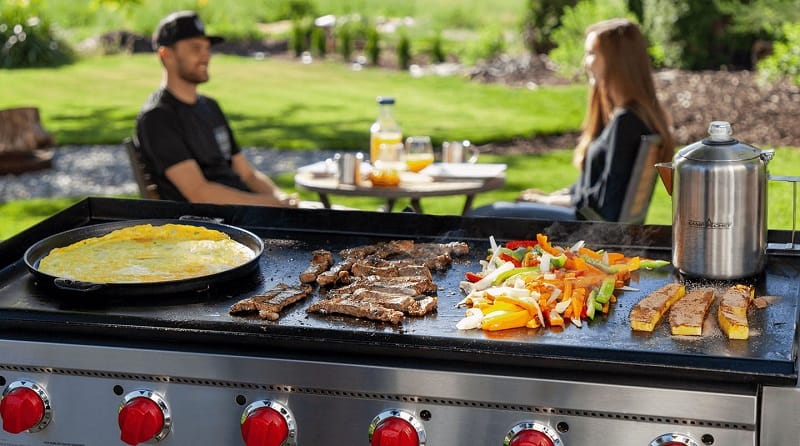
As a culinary enthusiast, I constantly explore new cooking techniques and appliances. One appliance that has been gaining popularity in recent years is the griddle. But what exactly is a griddle, and why should you consider adding one to your kitchen?
A griddle is a flat cooking surface typically made of cast iron, aluminum, or stainless steel. It’s similar to a frying pan or skillet but doesn’t have the raised edges. Most griddles are rectangular or square and can be placed over a stove burner or on a separate cooking surface.
One of the main benefits of a griddle is its versatility. You can use it to cook various foods, from pancakes and eggs to burgers and vegetables. It’s also great for cooking large batches of food, like feeding a crowd.
To use a griddle, you’ll need to preheat it over medium-high heat for a few minutes. Once it’s hot, you can add your ingredients and start cooking. Because a griddle doesn’t have raised edges, you’ll need to be careful not to let any liquids or grease spill over the side. You can use a spatula or other kitchen tool to flip and move the food around.
One thing to keep in mind when using a griddle is that it can get very hot, so you’ll want to use caution when handling it. It would be best if you also were sure to clean it thoroughly after each use to prevent food from sticking or any bacteria from growing.
See: https://tiredtexanbbq.com/blog/what-is-a-griddle/
Types Of Griddles
Griddles are an essential tool for any home cook or professional chef. They are versatile, easy to use, and can cook a wide variety of foods. However, not all griddles are created equal. Here, I will discuss the different griddles available and their unique features.
- Electric Griddles: Electric griddles are convenient and easy to use. They are perfect for small kitchens or for those who do not have access to a stovetop. Electric griddles are also great for cooking a wide range of foods, from pancakes to burgers to grilled cheese sandwiches. They are easy to clean and come with a non-stick surface.
- Cast Iron Griddles: Cast iron griddles are a classic and timeless option. They are durable and can last for generations. Cast iron griddles are also great for cooking various foods, from pancakes to steaks. They are perfect for outdoor cooking and can be used on a grill or over an open flame. Cast iron griddles require seasoning but are easy to clean and maintain once seasoned.
- Stainless Steel Griddles: Stainless steel griddles are durable and long-lasting. They are perfect for cooking various foods, from pancakes to burgers to grilled vegetables. Stainless steel griddles have a non-stick surface and are easy to clean. They are also great for outdoor cooking and can be used on a grill or over an open flame.
- Ceramic Griddles: Ceramic griddles are a newer option on the market. They are perfect for cooking a wide range of foods, from pancakes to eggs to grilled cheese sandwiches. Ceramic griddles are also great for outdoor cooking and can be used on a grill or over an open flame. They have a non-stick surface and are easy to clean.
- Non-Stick Griddles: Non-stick griddles are perfect for those who want to cook with minimal oil or butter. They are great for cooking a wide range of foods, from pancakes to eggs to grilled cheese sandwiches. Non-stick griddles are also easy to clean and maintain.
What is a Grill?
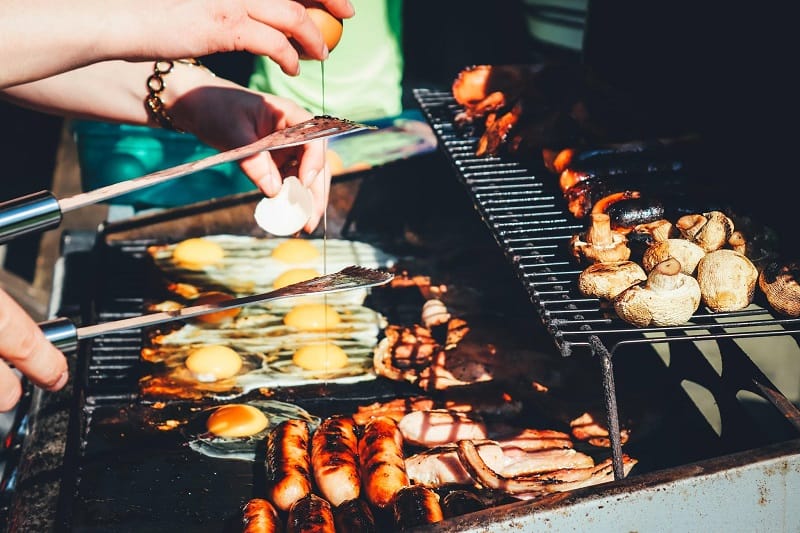
A grill is one of the most essential tools for any outdoor cooking enthusiast. But what exactly is a grill, and what makes it so important?
At its simplest, a grill is a cooking appliance that uses direct heat to cook food. This can be achieved through various methods, including gas, charcoal, or electric heating elements. Grills come in all shapes and sizes, from small portable models to large, permanent installations.
One of the main benefits of grilling is that it allows you to cook food quickly and efficiently. Because the heat source is in direct contact with the food, it cooks evenly and quickly, which is especially important when cooking meats.
Another advantage of grilling is that it imparts a delicious smoky flavor to food that other cooking methods can’t duplicate. This is because the grill’s high heat causes fat and juices to drip onto the heat source, creating smoke that infuses the food with flavor.
Of course, there are some downsides to grilling as well. For one, it can be difficult to control the temperature, which can lead to overcooked or undercooked food. Additionally, grilling can be messy, with grease and food debris accumulating around the grill.
Types Of Grills
I have experimented with different types of grills over the years. Each type has unique features and advantages, from the classic charcoal grill to the high-tech gas grills. Today, I will share my experience with different types of grills and help you choose the right one for your needs.
- Charcoal Grills: When it comes to the traditional grilling experience, nothing beats a charcoal grill. The smoky flavor and sear marks that it produces are unmatched. Charcoal grills are also affordable and easy to use. You only need some charcoal, lighter fluid, and a matchstick to start grilling. However, they require some patience and practice to master the art of temperature control.
- Gas Grills: If you are looking for a fast and convenient grilling experience, a gas grill is the way to go. They are easy to start and offer precise temperature control. Gas grills are also low maintenance and easy to clean. However, they lack the smoky flavor that charcoal grills offer.
- Pellet Grills: Pellet grills are a perfect combination of the convenience of gas grills and the smoky flavor of charcoal grills. They use wood pellets as fuel, fed into a hopper, and ignited by an electric starter. Pellet grills are versatile and can be used for grilling, smoking, and baking. However, they are expensive and require electricity to operate.
- Electric Grills: Electric grills are perfect for those who live in apartments or condos where charcoal or gas grills are not allowed. They are also great for indoor grilling. Electric grills heat up quickly and are easy to clean. However, they do not produce the smoky flavor of charcoal or pellet grills.
- Kamado Grills: Kamado grills are ceramic grills that are inspired by traditional Japanese cooking techniques. They offer excellent heat retention and precise temperature control. Kamado grills are versatile and can be used for grilling, smoking, and baking. However, they are expensive and require some practice to master temperature control.
Choosing the right grill depends on your needs and preferences. A charcoal or pellet grill is the way to go if you prefer the traditional smoky flavor. A gas grill is the best choice if you value convenience and speed. Electric grills are perfect for indoor grilling, while Kamado grills are ideal for those who want to take their grilling skills to the next level.
What Are The Similarities Between Griddle And Grill?
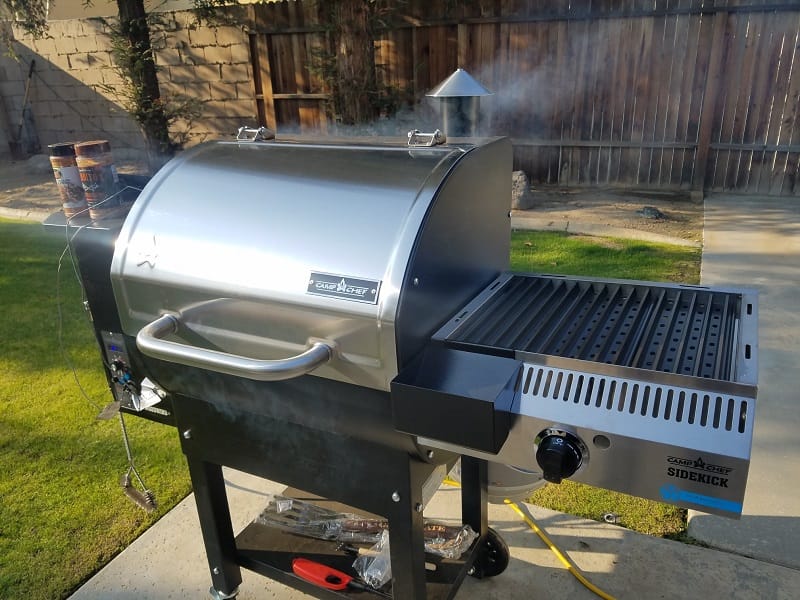
At first glance, they may seem very different, but there are quite a few similarities between griddles and grills.
Both griddles and grills are used for cooking food over an open flame or heat source. Griddles typically have a flat surface used to cook food, while grills have grates placed food. However, both surfaces can be made from various materials, such as cast iron, stainless steel, or ceramic.
Another similarity between griddles and grills is that they both allow for a high level of customization when it comes to cooking. You can cook various foods with a griddle, from pancakes and eggs to burgers and vegetables. Grills, on the other hand, are great for cooking meat but can also be used to cook fruits and vegetables.
Both griddles and grills also require a certain level of maintenance to keep them in good working order. Cast iron griddles and grills must be seasoned regularly to prevent rust and ensure food doesn’t stick to the surface. Stainless steel griddles and grills can be prone to scratching and require regular cleaning to keep them looking their best.
Finally, both griddles and grills can be used indoors or outdoors, depending on your needs and preferences. Griddles are great for indoor cooking, while grills are best used outdoors to prevent smoke and fumes from building up in your home or kitchen.
What Are The Main Differences Between Griddle vs Grill?
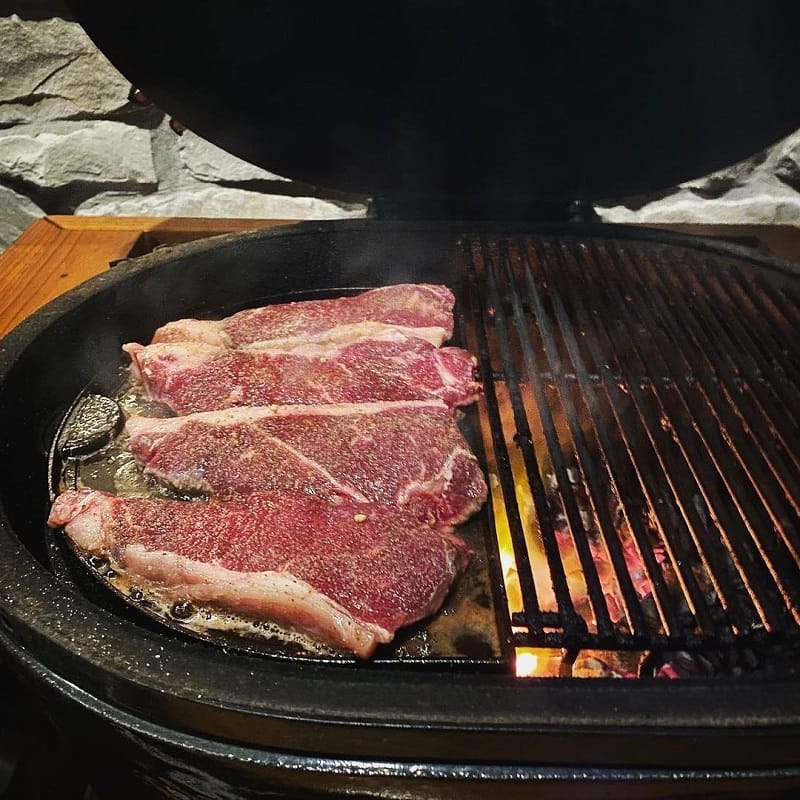
The main differences between a griddle and a grill lie in the cooking surface and technique. A griddle is a flat, smooth metal surface heated from underneath, while a grill has a series of slatted grates spread about half an inch apart over a heat source exposing food to an open flame.
Griddles cook food directly on their surface, spreading heat evenly across the entire cooktop without the flames touching the food. On the other hand, grilling uses higher temperatures than griddle cooking, and the heat transfers from the fire directly and through the metal of the grill grate.
Grills give off a lot of heat and smoke and are more commonly used outdoors, while griddles are predominantly used for indoor home or commercial cooking.
Understanding the differences between griddles and grills and the type of food suitable for each cooking surface is crucial to achieving the desired outcome.
Temperature
One of the most significant differences between griddles and grills is the temperature they can reach. Grills typically reach much higher temperatures than griddles. This is because grills use an open flame, which can reach up to 700 degrees Fahrenheit. Griddles, on the other hand, usually max out at around 450 degrees Fahrenheit.
Grease Control
Another critical difference between griddles and grills is the way they handle grease. Grills typically have a slanted surface that allows grease to flow away from the food and into a drip tray. This helps reduce the amount of oil that ends up in your food. Conversely, griddles have a flat surface that can trap grease, which can lead to more grease in your food.
Fuel Source
Grills typically use charcoal or gas as their fuel source. Charcoal grills provide a smoky flavor, while gas grills offer convenience and ease of use. Griddles, on the other hand, use electricity or gas as their fuel source. Electric griddles are easy to use and clean, while gas griddles provide more heat and are more versatile.
Surface
Grills typically have a grate surface that leaves grill marks on your food, giving it that classic grilled flavor. Conversely, griddles have a flat surface that is perfect for cooking pancakes, eggs, and other breakfast foods. Griddles can also cook burgers, steaks, and other meats, but they won’t have the same grill marks as a traditional grill.
Portability
Finally, portability is another factor to consider when choosing between a griddle and a grill. Grills are typically larger and heavier than griddles, making them more difficult to move around. Conversely, griddles are usually smaller and more lightweight, making them easier to transport.
Which Appliance Offers More Even Heat Distribution: A Griddle Or A Grill?
One of the biggest differences between griddles and grills is their heat distribution. Griddles offer a more even heat distribution compared to grills, making them ideal for cooking foods that require consistent heat, such as pancakes, eggs, and bacon. Grills, on the other hand, have a more uneven heat distribution due to the open flame, making them perfect for searing meats and vegetables.
Cooking Surface Area
Griddles provide a larger cooking surface area than grills, making cooking multiple items easier at once. This makes griddles perfect for cooking large batches such as pancakes, burgers, and hot dogs. Grills, on the other hand, have a smaller cooking surface area, making them ideal for cooking individual portions of meat and vegetables.
Upgrades
Griddles and grills also offer different upgrade options. Griddles can be upgraded with accessories such as a griddle cover, which helps retain heat and prevent splatters. Grills can be upgraded with temperature controllers, which allow for precise cooking temperature control. These upgrades can help improve the cooking experience and make cooking different types of food easier.
Cooking Time
Finally, cooking time is an important factor to consider when choosing between griddles and grills. Griddles offer a faster cooking time than grills, making them ideal for busy mornings when you need a quick breakfast. Conversely, grills offer a slower cooking time, allowing for more flavor development when cooking meats and vegetables.
Which Appliance Is Generally Larger And Heavier: A Griddle Or Grill?
Regarding size and weight, grills tend to be larger and heavier than griddles. This is because grills are designed to accommodate larger quantities of food, and they typically have more features, such as multiple burners, side shelves, and warming racks. Conversely, griddles are more compact and lightweight, making them ideal for smaller kitchens or outdoor cooking.
Glance
At first glance, griddles and grills may look quite similar, but there are some key differences in their design and functionality. Grills are typically open grates that allow direct heat and smoke to reach the food. Conversely, griddles have a flat surface that allows for even heat distribution and the ability to cook multiple items at once.
How Does Price Compare Between Different Griddle And Grill Models?
When it comes to price, a wide range of options are available for both griddles and grills. The cost of a grill typically depends on its size, features, and quality of materials. Conversely, griddles are generally more affordable and can be a great option for those on a budget. However, it’s essential to keep in mind that higher-end griddles can be just as expensive as some grills.
Griddle vs. Grill: Which One is Easier to Clean?
Cleaning can be a significant factor when choosing between a griddle and a grill. Grills can be more challenging to clean due to their open grates and narrow spaces. Griddles, on the other hand, have a flat surface that makes cleaning easier. It’s also worth noting that spiders typically have a removable drip tray that can be washed separately.
Which Is Better, Grill or Griddle?
It depends on your cooking needs when deciding which grill or griddl is better. If you love the taste of grilled food and want to cook outdoors, a grill is the way to go. Grills are perfect for searing steaks, grilling vegetables, and creating that distinctive smoky flavor. However, a griddle is a great option if you’re looking for a versatile cooking surface that can handle a wide range of foods. Griddles are perfect for cooking breakfast foods like pancakes, eggs, and bacon, as well as grilled sandwiches, burgers, and more.
Read more:
- Can You Grill Frozen Chicken
- Smoking vs Grilling
- Smoker Vs Pellet Grill
- Can You Grill In The Rain
- How Long Cook Steak On George Foreman Grill
- Can You Use Pellets in a Charcoal Grill
- How Long Does Charcoal Last
- When Is Charcoal Ready
When Is It Best To Use A Griddle, And When Is It Best To Use A Grill?
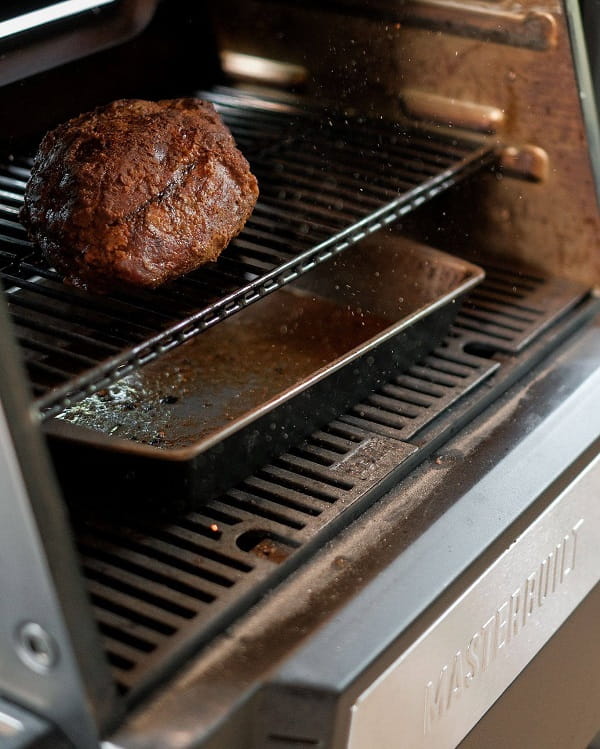
When it comes to outdoor cooking, choosing the right cooking surface can make all the difference in the success of a meal. Griddles and grills are two popular options with unique features and strengths.
Griddles, with their flat metal cooking surface heated from underneath, are best suited for cooking granular foods like rice or liquid-heavy dishes like pancakes and eggs. Traditional breakfast foods like bacon, sausages, and eggs are also a perfect fit for the high heat of a griddle.
On the other hand, grills with their heating element and grate are ideal for cooking meats like burgers, steaks, and hot dogs. The smoky flavor of using a grill cannot be replicated on a griddle, making it the clear winner for meat dishes.
Ultimately, the choice between a griddle and a grill depends on the type of food being prepared and personal preferences.
Pros And Cons Of Griddle
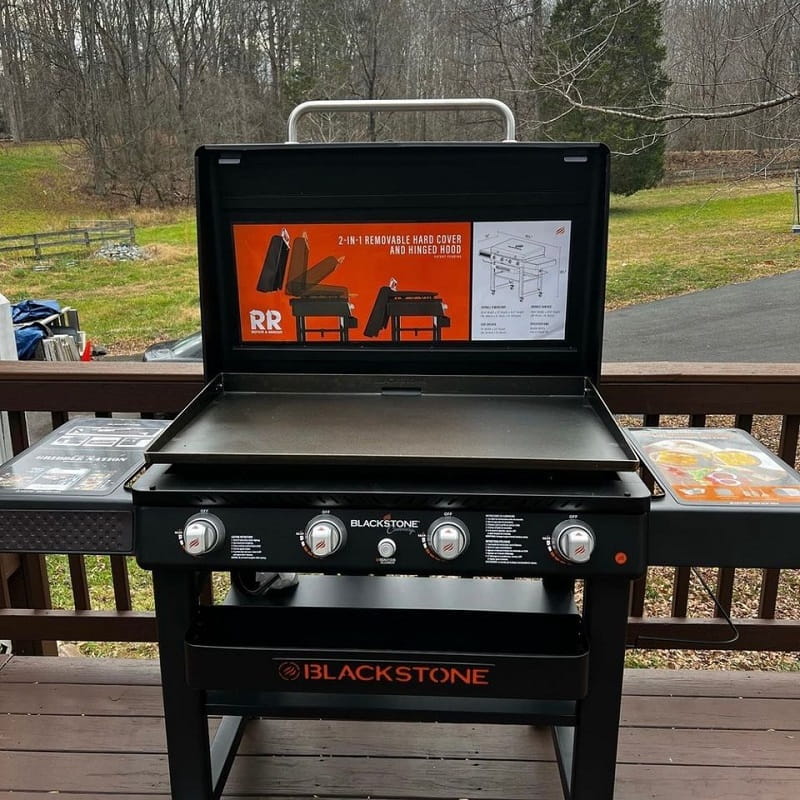
While there are certainly some advantages to using a griddle, there are also a few drawbacks to keep in mind. Here, I’ll explore the pros and cons of cooking with a griddle.
Pros:
- Versatility: Griddles can be used for various foods, from pancakes to grilled cheese sandwiches to burgers and vegetables. They provide a flat surface that allows you to cook multiple items at once, making meal prep more efficient.
- Easy to use: Griddles are easy to operate, with simple temperature controls that allow you to adjust the heat according to your needs. They are also easy to clean, with most models featuring a non-stick surface that prevents food from sticking.
- Healthier cooking: Griddles are a healthier option than traditional frying pans, requiring less oil or butter to cook food. This means that your meals will be lower in fat and calories.
- Faster cooking time: Griddles cook food faster than traditional frying pans, especially when cooking multiple items. This means you’ll spend less time in the kitchen and more time enjoying your meal.
Cons:
- Limited cooking space: While griddles are great for cooking multiple items simultaneously, they have a limited cooking surface. If you’re cooking for a large family or hosting a dinner party, you may need to cook in batches or use multiple griddles.
- No ridges: Unlike traditional frying pans, griddles don’t have ridges that allow excess fat and grease to drain away from the food. This means your food may be slightly greasier than if cooked on a ridged pan.
- Less flavor: Griddles don’t provide the same level of flavor as traditional frying pans, as they don’t allow the food to caramelize. This means your food may be less flavorful than cooked in a traditional pan.
- More expensive: Griddles are more costly than traditional frying pans, especially if you’re looking for a high-quality model. This means that you’ll need to be willing to invest more money upfront to enjoy the benefits of a griddle.
Pros And Cons Of Grill
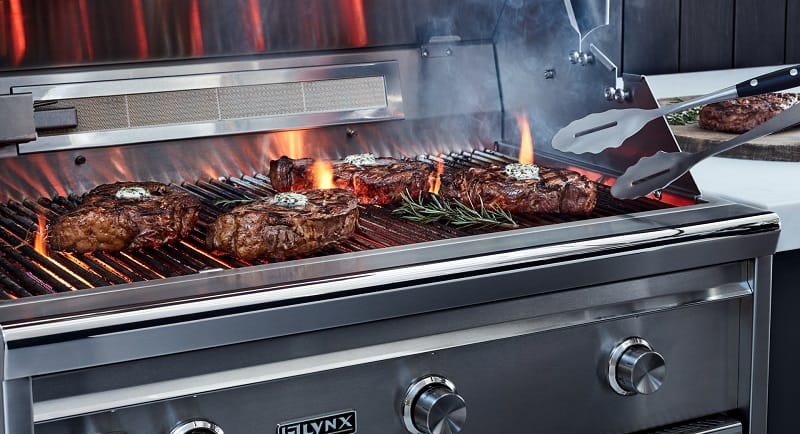
Before you invest in a grill, it’s important to weigh the pros and cons. Here, I’ll be sharing my experience with grilling and discussing the pros and cons of owning a grill.
Pros:
- Flavor: One of the biggest advantages of grilling is the unique flavor it adds to food. The smoky flavor from grilling can’t be replicated by any other cooking method.
- Versatility: Grilling allows you to cook a wide variety of foods, from vegetables to meats and even fruits. You can experiment with different flavors and cooking methods to create delicious meals.
- Outdoor Cooking: Grilling is the perfect way to enjoy the outdoors while cooking. It’s a great way to entertain guests and enjoy the fresh air.
- Healthier Cooking: Grilling is a healthier cooking option compared to frying or baking. When you grill, excess fat drips off the meat, reducing the overall fat content of the food.
Cons:
- Maintenance: Grills require regular maintenance and cleaning, especially if you want them to last for years. Grease and food particles can build up over time, leading to rust and corrosion.
- Cost: Grills can be expensive, especially if you’re looking for a high-quality model. Also, ongoing costs such as fuel and maintenance are associated with grilling.
- Weather-Dependent: Grilling is weather-dependent and can be challenging in extreme weather conditions. High winds, rain, and snow can make grilling difficult.
- Time-Consuming: Grilling can be time-consuming, especially if you cook for a large group. Preheating the grill, cooking, and cleaning up can take significant time.
What Types Of Foods Are Best Cooked On A Griddle?
- Pancakes – Griddles are perfect for making fluffy and evenly cooked pancakes.
- Hamburgers and Sliders – Griddles can perfectly cook burgers and sliders with crispy edges and juicy centers.
- Fajitas – Griddles are great for sizzling fajitas, giving peppers and onions a lightly charred flavor.
- Breakfast Scrambles – Griddles make it easy to cook breakfast scrambles that are perfectly cooked and ready in no time.
- Grilled Cheese Sandwiches – Griddles create crispy and melty grilled cheese sandwiches that are a comfort food favorite.
- Fried Rice – Griddles are perfect for making delicious fried rice, with evenly distributed heat that ensures each grain is perfectly cooked.
- Chicken – Griddled chicken breasts and tenders are easy to make and cook perfectly for a quick and satisfying meal.
- Kabobs – Griddles are great for kabobs, with their flat surface making it easy to rotate the skewers for even cooking.
- Chili Dogs – Griddles are perfect for cooking chili dogs with crispy buns and perfectly cooked sausages.
- Asparagus and Broccoli – Griddling these veggies makes them tender with a bit of a bite while adding a lightly charred and smoky flavor.
What Types Of Foods Are Best Cooked On A Grill?
Foil packets are the epitome of a summer meal – simple and quick with easy cleanup. You can mix veggies and chicken with fajita spices to create a Tex-Mex dish or use tomatoes for a slight bitterness that balances acidity and brings out umami flavors. Don’t forget beer brats for a classic grilled American dish.
- Corn: Corn on the cob is the perfect vegetable for grilling due to its simplicity. Soak it before grilling for the best results.
- New York Strip Steak: A beginner’s best friend, New York strip steak is tender and easy to cook. Cook for two to three minutes, then rotate until the desired temperature is achieved.
- Grilled Beef Short Ribs: Short ribs are easy to prepare and cook quickly. Plus, the fat and bones add natural flavor.
- Heartier Fishes: Firm, flavorful fishes like mackerel are ideal for charring on the grill. Pair with anchovy butter for added flavor.
- Tofu: Vegetarians and vegans can enjoy grilled tofu, which absorbs a lot of flavor. Marinate with soy sauce, garlic, or fresh herbs for added taste.
Note: Be cautious when grilling foods like flaky fish and tomatoes, as they can fall apart on the grill.
FAQs About Griddle vs. Grill
What Is The Maximum Cooking Temperature Achievable On A Griddle Or Grill?
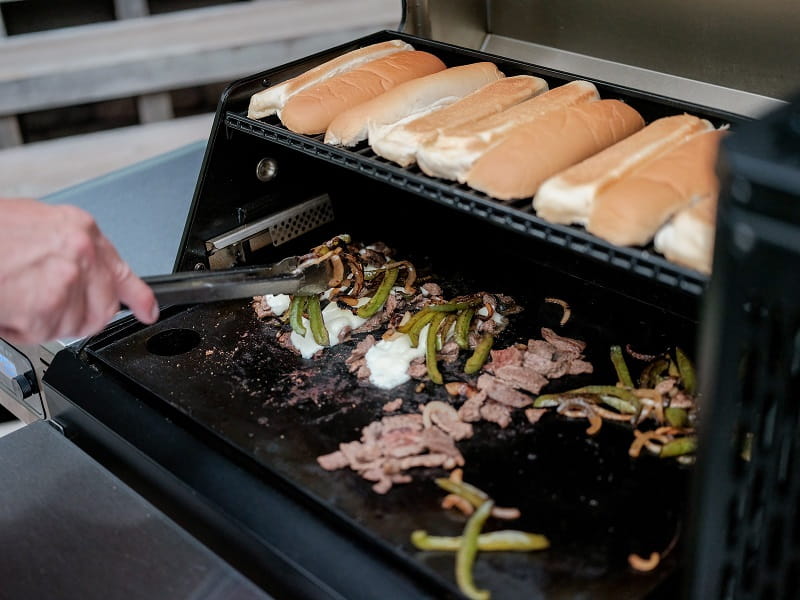
Griddles and grills can get extremely hot, with some capable of reaching temperatures over 650°F under ideal conditions. However, it is essential to note that the highest temperature is not always necessary for cooking.
Most foods can be cooked on a griddle or grill between 300°F and 400°F with consistently excellent results. The Maillard reaction, which occurs between 280°F-330°F, is essential for achieving the perfect browning, intensifying flavor, and making food more delicious.
It is recommended to use an instant-read thermometer to accurately determine how long food needs to cook before flipping. Understanding the variables that affect griddle and grill temperature, such as the volume and temperature of the food being cooked, can help determine the optimal cooking temperatures for achieving the perfect results for any dish.
Can You Achieve The Same Results With A Griddle As You Can With A Grill?
The answer is it depends on what type of food you’re cooking. Griddles are great for cooking breakfast items like pancakes, eggs, bacon, burgers, and sandwiches. Griddles offer even heat distribution, so food can cook evenly without the worry of burning or undercooking.
Grills are ideal for cooking meats like steaks, chicken, and pork chops, as they provide a smoky flavor that can’t be replicated on a griddle. Grills allow the meat’s natural juices to be preserved, resulting in a juicy, flavorful meal.
Conclusion
In conclusion, both griddles and grills have their pros and cons. Griddles are great for cooking foods that need to be cooked evenly on both sides, while grills are great for searing foods quickly. Ultimately, it comes down to personal preference and what you’re cooking. So, whether you’re a griddle person or a grill person. However, whatever you decide, keep your griddle or grill clean and well-maintained to ensure it lasts for years. Happy cooking!
Do you have any questions about Griddle vs Grill? Let us know in the comments below.
References:
- https://www.insider.com/best-and-worst-foods-to-cook-on-a-grill-chefs
- https://blackstoneproducts.com/blogs/griddling-tips-tricks/griddle-temperature-guide
- https://izzycooking.com/griddle-recipes/

Hey readers! Chip Holland here, and I’m a Manager of this website. My passion for writing about it only matches my passion for BBQ. Follow my blog for mouth-watering recipes, tips, and tricks for the perfect smoke, grill, and BBQ. I’m sure you won’t be disappointed!
